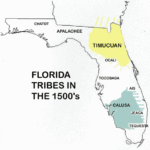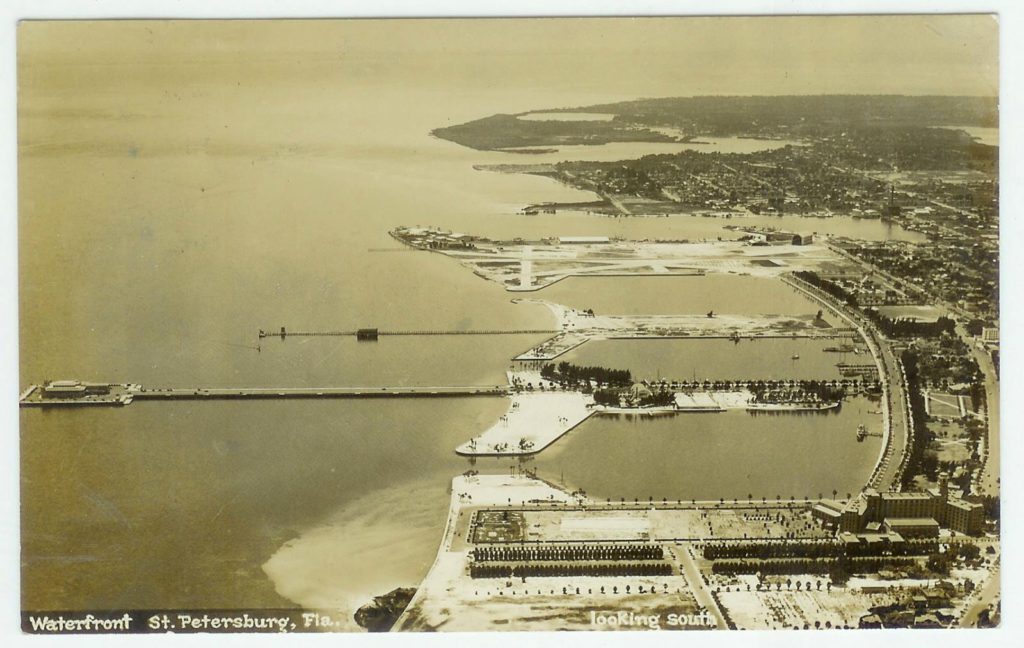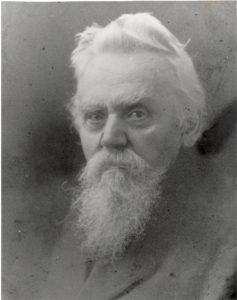
Long before the first Spanish explorers reached Tampa Bay, the St Petersburg peninsula was the home of major Native American civilizations. The Weedon Island culture, for example, is named for a site in St. Petersburg. From its origin nearly 2,000 years ago to its final disappearance 1,000 years later, this civilization spread over Florida and parts of Alabama and Georgia.

The Weedon Island people were followed by the Tocobaga, a Mississippian culture that built mounds throughout the area. The Tocobaga still lived in the region when the Spanish explorer Panfilo de Narvaez landed on the Pinellas Peninsula in 1528. The Pinellas Point Temple Mound is the traditional site where a Tocobaga princess saved the life of Juan Ortiz, a sailor captured from a supply expedition that followed on the heels of Narvaez. Some scholars believe the story of Ortiz and the Princes Hirrihigua was the inspiration for the later story of John Smith and Pocahontas.
Hernando De Soto sailed into the waters off St. Petersburg in 1539 en route to a landing somewhere in the Tampa Bay area and the eventual discovery of the Mississippi River. Other explorers and then Cuban fishermen followed, as did pirates. The famed pirate Gasparilla (Jose Gaspar) supposedly sailed the waters off St. Petersburg, as did other corsairs of the Gulf until the U.S. Navy finally put an end to the pirates.

The first real land investor came from Detroit in 1875. General John Williams bought 2,500 acres of land on Tampa Bay. He was a man with visions: broad streets, beautiful parks, a city with public areas close to the shores… Named after his home town, he built the first hotel in the city, The Detroit, which is still in operation. Was he a man with the future on his mind!
As opposed to many other areas in the growing US, the first settlers in the St Pete area was not the white man, it was Afro-Americans. John Donaldson and his wife Anna Germain arrived in 1868 and created a homestead on what became 18th Avenue S and 31st Street S. But it was the laborers who built the Orange Belt Railway, who stayed and started to build their own life, as free men. But the railway also brought the white man, who started to build a more structured type of community.
St Pete had its first heyday period during the 1920: s. It was the growing interest for healthy living in a desirable climate that brought the first wave of tourists. And that brought a landslide of land- and property investors. St Petersburg was the place to go to, St Pete was “hip”, long before the word itself was even invented.

But then came the 30: s, with the depression and financial crises. People moved away, shops and services closed down, value of land and property dropped and tourism vanished. And then came WW2.
The US engagement in the WW2 ment that the US had to build up and educate troops, to send abroad but also to defend its on shores from German attacks. And thousands and thousands of recruits were stationed in the Pinellas and Tampa area for training. All available empty hotel space (and there was a lot of that…) became requisitioned for housing. That way, historical hotels like the Vinoy, the Cesár and many others were all of a sudden transformed to soldier quarters.
All these tens- and thousands of young men and women also ment a new life for the area. And a need for supply resources from the residents of St Pete and Pinellas.
Eventually the WW2 came to an end. And all the military activities disappeared. No doubt, the military presence saved St Pete from falling even further down a financial negative spiral. Many in the military services stayed, as they liked the climate and the area. They got married, they started to build families and jobs were created. But what the militaries left behind was a shattered and worn out environment – not least all these beautiful hotels.
But this was also the beginning of a new and prosperous time. Which is still going on…


Why this name..?
It was the railroad which colonized Florida. Roads in the mid 1800’s were just dirt tracks (asphalt was still not invented) and they were very local – there wasn´t any state-covering grid of roads. And the car was just recently invented. And yes, railroads were built: Henry Flagler built the entire system on the eastern side, eventually down to what should become Miami. Henry Plant built his railroad system going down to a small and rather unknown place which was called Tampa.
But many other railways were built. An optimistic but poorly financed project that would tie together the east and west side of Florida capsized. Three men who were sawmill owners and had not been paid for delivered railroad ties; instead they got a half-finished railroad as a mortgage. The gentlemen had the names of Taylor, Sweetapple and Demens. But Peter Demens real name was Pyotr Alexeyevitch Dementyev and he came from St. Petersburg in Russia.
The extension of “The Orange Belt Railroad” was not exactly a success. In short, the money dried up. Entering the stage, a Swedish gentleman with the name Josef Henschen.

Mr. Henschen had arrived to Florida in 1871 with some 35 Swedish workers to organize and cultivate citrus groves on the eastern side of Florida. It went well, very well. He invested and built up a decent fortune in this kind of business. He became a partner with the three railway owners, investing his money and organizational talent and completed the railroad extension. On the west side, the railroad was built all the way out into the middle of nowhere on that peninsula which today is called Pinellas County. And as usual where the railroad paved ground, homes were built, bars and small shops and all that creates civilization popped up. In short, a small city started to grow. And a city must have a name. Josef Henschen has himself told the story:
– There was already a small town named after Taylor, you can´t call a town for Sweetapple. The Americans would never be able to pronounce or spell Henschen the right way.

So Josef decided to honor Peter Demen’s hometown and put in the proposal St. Petersburg for registration. So that way a Swede named a city in Florida-USA, which has a Russian counterpart.
As to the railroad, Josef Henschen and not least St. Petersburg, Florida – that is a totally different story..

